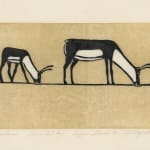-
Artworks
JOSEPHIE POOTOOGOOK (1887-1958) KINNGAIT (CAPE DORSET)
Caribou (Summer Caribou), 1958Printmaker: JONASSIE SALAMONIE (1938-1998) KINNGAIT (CAPE DORSET)
linocut, 6 x 8 in (15.2 x 20.3 cm), framed.
8/30Lot 32
ESTIMATE: $4,000 — $6,000
PRICE REALIZED: $4,080.00Illustrated in the AGO’s Inuit Modern catalogue (p. 70), the elder Pootoogook's original graphite drawing reveals a starkly different vision from the present print — a hunting scene that features...Illustrated in the AGO’s Inuit Modern catalogue (p. 70), the elder Pootoogook's original graphite drawing reveals a starkly different vision from the present print — a hunting scene that features two hunters with rifles closing in on a caribou and its two calves. Emerging from Kinngait's nascent graphic art scene, this work underwent a transformation from drawing to print, abandoning the image of a hunt in favour of one with an aura of serene tranquility. First appearing in 1957-58 in an exhibition at the Hudson’s Bay Company in Winnipeg, the image was marketed as Grazing Caribou, although the prints themselves simply carried the inscription Caribou, as in the present lot. Later, in a 1975 essay for The Beaver, Mary Craig rechristened this golden-hued composition of a foraging caribou and its young as Summer Caribou (p. 25). The total number of prints on yellow or blue grounds remains uncertain for both proofs and editions, though the yellow version appears notably less frequently in the market. Amidst these metamorphoses and shifts in subject and names, this gorgeous print adds a fascinating perspective on what is retrospectively known as Cape Dorset’s earliest "Experimental Collection," all the while preserving its timeless allure and beauty.
References: See Gerald McMaster, ed., Inuit Modern: The Samuel and Esther Sarick Collection, (Toronto: Art Gallery of Ontario, 2010), p. 70, for the original graphite drawing and blue background prin. The yellow ground image is reproduced in Norman Vorano, Inuit Prints: Japanese Inspiration, (Gatineau: Canadian Museum of Civilization, 2011), fig. 7, p. 7. This version is curiously dated 1957 and inscribed “#13.” However, Barz explains in her notations for Caribou, there are a number of prints in circulation, without editions, which Mary Craig explained to Barz were “were from a number of proofs, which Alma and Jim Houston sent out to friends of Inuit art as gifts at holiday time.” It is likely that the version in Vorano’s book is one such proof. The image itself lists the print as a stonecut but the technique is linocut, as indicated by Sandra Barz in her Inuit Artist Print Database notations for this print. See Sandra Barz, Inuit Artist Print Database, notations for “Caribou” and “Grazing Caribou / Summer Caribou” for her account of the various names and origins. It is worth noting that Mary Craig in “The Cape Dorset Prints,” The Beaver, Spring 1975, p. 25, refers to the print as being from her own collection. It is, thus, conceivable that it did, indeed, bear this inscription but this remains unclear. The 1957 image on a blue ground, is reproduced in Leslie Boyd Ryan, Cape Dorset Prints: A Retrospective, (San Francisco: Pomegranate, 2007), p. 27, as Caribou; Gerald McMaster, ed., illustrated with the original drawing; and in Darlene Coward Wight, Creation and Transformation: Defining Moments in Inuit Art, (Winnipeg: Winnipeg Art Gallery, 2012), cat. 15, as Caribou.
Provenance
Collection of John and Joyce Price, Seattle.
Join our mailing list
* denotes required fields
We will process the personal data you have supplied in accordance with our privacy policy (available on request). You can unsubscribe or change your preferences at any time by clicking the link in our emails.




